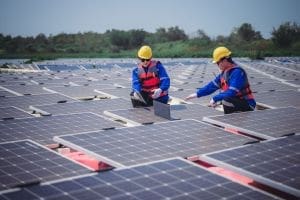
The Bureau of Land Management (BLM) has unveiled a new strategic plan to enhance solar energy development on public lands, focusing on efficient and environmentally conscious permitting processes across the Western United States. This initiative, known as the Final Utility-Scale Solar Energy Programmatic Environmental Impact Statement and Proposed Resource Management Plan Amendments, or the updated Western Solar Plan, aligns with the federal government’s efforts to streamline federal permitting and expedite the rollout of clean energy projects nationwide.
Steve Feldgus, Principal Deputy Assistant Secretary for Land and Minerals Management, emphasized the importance of the updated plan, stating, “The revised Western Solar Plan is crucial for constructing resilient energy infrastructure that fosters a robust clean energy economy while safeguarding our communities from the escalating effects of climate change.” He highlighted that this plan was developed through extensive collaboration and is designed to protect public lands while accelerating the permitting process for solar projects, ensuring a balanced approach to advancing clean energy while preserving the environment.
The Importance of the Updated Western Solar Plan
The updated Western Solar Plan, which was shaped by public input, will guide BLM’s management of solar energy proposals on public lands. It opens up more than 31 million acres across 11 Western states for potential solar development, prioritizing locations near transmission lines or on previously disturbed lands. This approach helps avoid areas with protected lands, sensitive cultural resources, and critical wildlife habitats.
This plan represents an update and expansion of the original 2012 Western Solar Plan, reflecting advancements in technology and the growing demand for solar energy. The new plan includes five additional states—Idaho, Montana, Oregon, Washington, and Wyoming—along with the six states originally covered.
BLM Director Tracy Stone-Manning described the updated Western Solar Plan as a “responsible and practical strategy” for advancing solar energy on public lands. She stressed the plan supports national clean energy goals and enhances long-term energy security, all while promoting responsible solar development in areas with fewer potential conflicts. This effort aligns with BLM’s mission to maintain the health, diversity, and productivity of public lands for both current and future generations.
The Impact of the Updated Western Solar Plan
Each proposed solar project will still require a site-specific environmental review and public comment. This last statement follows a draft published in January 2024, which was open for public comment. Feedback from stakeholders helped BLM refine the plan to better protect wildlife habitats, migration corridors, and other essential resources while providing the industry with clearer guidance on low-conflict areas and project design for responsible development.
To date, the federal government has approved 40 renewable energy projects on public lands, including nine solar, 13 geothermal, and 18 gen-tie projects, achieving its goal of permitting 25 GW of renewable energy by 2025. The BLM has now permitted clean energy projects with a total capacity of about 29 GW, enough to power over 12 million homes. The BLM issued a final Renewable Energy Rule this year aimed at reducing consumer energy costs, improving the project application process, and motivating responsible solar and wind development on public lands.
Where Do We Go From Here?
The release of the Final Utility-Scale Solar Energy Programmatic Environmental Impact Statement and Proposed Resource Management Plan Amendments initiates a 30-day protest period and a 60-day governor’s consistency review. Once any remaining issues are resolved, the BLM will publish the Record of Decision and Final Resource Management Plan Amendments.
This updated Western Solar Plan is a critical component of the government’s efforts to transition the nation to clean energy, lower consumer energy costs, create union jobs, address the climate crisis, and advance environmental justice. The goal is to achieve a 100% clean electricity grid by 2035. Earlier this year, BLM surpassed its goal of permitting over 25 GW of clean energy projects on public lands, and this updated plan will further support responsible permitting and development.
Ben Norris, VP of Regulatory Affairs at the Solar Energy Industries Association (SEIA), noted, “Expediting well-planned clean energy projects on federal lands is one of the quickest ways to decarbonize our grid, and the improvements in this environmental review document will significantly aid that effort.” He added that SEIA will continue collaborating with BLM and other federal agencies to promote responsible, clean energy development on public lands and to streamline the permitting process.
Source: Solar Power World
